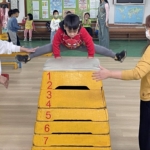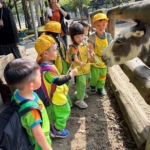Thanksgiving cards were posted in the activity room, attracting the attention of adults and children, who stopped to appreciate the cards that came from parents and children working together. Each card represented the heart of the parents and their accompanying hearts, guiding children to use their pens to draw and use their mouths to express their gratitude to people, things, and objects, and to present the gratitude in their hearts as images. Thanksgiving card is not about how beautiful the drawing is or how nice the work is, but the content of the card, which is a record, and with the passage of time, a memory that records the child's feelings at that time and the language of the drawing.
Gratitude begins with a simple thank you. Thank you to my mom and dad for giving me a warm home, so I don't have to worry about food and clothing, and I can go to kindergarten; thank you to my grandparents for loving me and taking care of me; thank you to those who do things for me beside me; thank you to my classmates for studying with me and growing up with me; thank you to my teachers for teaching me; thank you to my healthy body; thank you to my farmer for planting rice and growing vegetables; thank you to my bread baker for baking fragrant bread. Thank you for the sunshine, air and water that allow us to live .......
Every day, the children will thank their teachers and also thank each other for the children learning and playing with them.
During the season of gratitude, make saying thank you a good habit.
Saying thank you makes this world a better place and allows us to feel the grace of existence.
In the fall and winter, the northeastern monsoon reported, the mainland haze with the monsoon to Taiwan, the sky is often a misty, Taiwan every year for half a year to monopolize the dirty air under. Air is one of the necessary conditions for living beings to survive, and air pollution concentration exceeding a certain standard is harmful to the human body and the environment.
This morning, a "Red Alert" flag was displayed on the Environment Watch, reminding people to pay attention, wear masks and walk less outdoors.
Share and discuss with the children to take care of their own bodies through small actions. Every day, they should look at the flags at the door, understand the good and bad air quality, and take good protective actions; from the aspect of caring for the environment, what can the children do?
"Garbage Separation" "Reduce Use of Plastic Bags" "Don't Litter" "Save Water" .......
The good habits you develop at an early age will serve you well throughout your life.
The children are looking forward to next week's Fall Outdoor Learning-Thanksgiving trip to the Duck Farm in Tainan. We asked the children if they had ever seen a duck. Some nodded, some shook their heads. Have you ever seen a chicken? More of them nodded their heads. What is the difference between a chicken and a duck? Chickens have pointy beaks, ducks have long flat beaks; roosters have crowns, ducks don't; ducks can swim, chickens can't; why can ducks swim? The clever Yuk Cheung said, "Because ducks have webbed feet and chickens don't".
Choose an outdoor learning location from large and small teaching themes, considering factors such as travel distance, space, cost, children's physical strength, educational significance, fun and safety to decide where to travel.
Through the outdoor education organized by the school, under the leadership of the principal and teachers, not only the children's horizons and learning areas are broadened, but more importantly, teamwork and independence are learned.
Have a nice vacation. Peace and happiness.
Mandy







